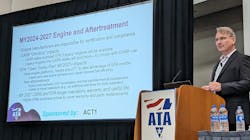EPA’s new HD emissions rules push manufacturers and fleets to plan ahead
The U.S. Environmental Protection Agency published its final new rule for heavy-duty engines and vehicles in the Federal Register on Jan. 24, officially creating more stringent emissions rules for truck OEMs. As manufacturers refine and develop the technology to meet the next step of the EPA's Clean Truck Plan, fleets should consider how it affects their operations.
With the new emissions rules beginning with model year 2027 large trucks and engines, now is the time for fleets to start planning procurement strategies, according to Dan Porterfield, SVP of maintenance and equipment control at Covenant Logistics. He noted that diesel has been the fuel of choice in the trucking industry because it's "very, very cheap to operate."
See also: EPA sets stricter smog rule for model year 2027 trucks
"As we keep adding regulations to the diesel engines, that makes them more expensive to operate," Porterfield said during American Trucking Associations' Management Conference and Exhibition late last year. "Diesel parity isn't necessarily coming because the other (fuel sources) are getting cheaper; it is because diesel is getting more expensive."
He expects new heavy-duty regulations, like the EPA published this week, will push fleets to look more closely at alternative fuels and how they work. "You need to start planning ahead," Porterfield advised fleet leaders. "This is going to be coming out fast. You need to be thinking about how to get information, knowledge, and skills."
New HD standards mean new technology
Engine manufacturers will be responsible for certification and compliance with the latest heavy-duty standards, which will require new technology—both hardware and software, according to Matthew Spears, executive director for global regulatory affairs at Cummins, which is among the largest producers of Class 8 engines in the U.S.
Spears said engine-makers such as Cummins should have enough lead time to develop and launch new products to comply with EPA's 2027 timeline. "You can definitely expect to see new engine hardware and new aftertreatment hardware," he said during the same ATA panel before the EPA finalized its rule. "There are a number of technology paths that could or should be available to comply."
See also: Cummins is finding more than one way to decarbonize fleets
In 2022, the Southwest Research Institute demonstrated the effectiveness of its Catalyzed Diesel Exhaust Fluid technology, known as CAT-DEF, which is an institute-developed catalyst- and surfactant-modified diesel exhaust fluid solution. According to the institute, SRI's novel technology decreases NOx and carbon dioxide emissions for diesel engines by significantly reducing undesirable deposit formation in exhaust systems.
"Although DEF technology has been utilized for more than a decade, the highest emissions control efficiencies could never be realized due to DEF's tendency to create potentially harmful deposits in the exhaust system, particularly when the engine is operated at low loads and temperatures," said Dr. Charles E. Roberts Jr., director of SRI's Commercial Vehicle Systems Department. "A combination of surface-active agents and heterogenous catalysts blended into CAT-DEF reduces deposits by 90% with potential reductions up to 98%."
Spears said the institute used a Cummins X15 as the base engine for its technology, modified with a different valve train that allowed for cylinder deactivation. The institute also added a second aftertreatment system on the upstream selective catalytic reduction (SCR) between the turbocharger outlet and diesel particulate filter.
"So they had two SCR systems and cylinder deactivation—it was a much larger system as well," Spears explained. "I'm not going to get into specifics of what technologies other manufacturers or Cummins might be looking at, but we have to take a hard look at that type of technology to consider what might be needed in order to comply."
Hardware changes, such as this, and other new technologies "might be coming your way in the 2027 timeframe," Spears said in October. "With the new hardware and lower NOx emissions requirements, we can expect DEF consumption to go up somewhat but not that significant because we're already using DEF to get very, very significant, 90-plus percent reductions in NOx. Getting that extra 5% is going to translate into additional DEF consumption."
Spears said he doesn't anticipate this kind of technology interrupting fleet operations. For example, truck engines would not need to run idle for a more extended period before becoming EPA-compliant.
'Strongest-ever' national air standards
After initially announcing the new emissions rules on Dec. 20, the finalized regulations for heavy-duty trucks and engines apply to model year 2027 equipment were published in the Federal Register on Jan. 24. They take effect 60 days later on March 27 with the goal of reducing air pollution—including pollutants that create ozone and particulate matter—from large trucks.
According to the published rules, the emission reductions will increase over time as more new, cleaner vehicles enter the market.
"We estimate that the final rule will reduce [NOx] emissions from heavy-duty vehicles in 2040 by more than 40%; by 2045, a year by which most of the regulated fleet will have turned over, heavy-duty NOX emissions will be almost 50% lower than they would have been without this action," according to an EPA summary within the final rulemaking.
See also: Industry reacts to EPA's truck, engine emissions proposal
The new standards require heavy-duty commercial vehicles to limit NOx emissions to 0.035 grams per horsepower-hour during normal operation, 0.050 grams at low load, and 10 grams at idle. According to the latest regulations, warranties will be extended to 450,000 miles from 100,000 miles and the useful life of a covered commercial vehicle to 650,000 miles from 435,000 miles.
The new rules also are the first move in EPA's three-step Clean Truck Plan to be followed by proposed Phase 3 GHG standards for heavy-duty vehicles beginning in model year 2027 and multipollutant standards for light- and medium-duty vehicles starting with that same model year.
The final EPA commercial vehicle regulation includes new, more stringent emissions standards covering a more comprehensive range of heavy-duty engine operating conditions than today's standards. According to an EPA rule summary published on its website, it requires these stricter emissions standards to be met for a longer time when these engines operate on the road.
This final rule is compatible with President Biden's executive order, "Strengthening American Leadership in Clean Cars and Trucks," and is the first step in the federal Clean Trucks Plan, according to the EPA. In addition, the final rule includes other limited amendments to the regulations that implement air pollutant emission standards for different sectors (e.g., light-duty vehicles, marine diesel engines, locomotives, various types of nonroad engines, cars, and equipment).
Relative to current rules, the new standards are more than 80% stronger, increase the useful life of governed commercial vehicles by 1.5–2.5 times, and would yield emissions warranties that are 2.8–4.5 times longer, according to EPA. This final rule includes provisions for longer functional life and warranty periods. These provisions guarantee that as target vehicles age, they would continue to meet EPA's more stringent emissions standards for extended periods.
The rule also requires manufacturers to ensure that vehicle engines and emission control systems work correctly on the road. For example, manufacturers must demonstrate that engines are designed to prevent vehicle drivers from tampering with emission controls by limiting tamper-prone access to electronic pollution controls.
About the Author
Josh Fisher
Editor-in-Chief
Editor-in-Chief Josh Fisher has been with FleetOwner since 2017. He covers everything from modern fleet management to operational efficiency, artificial intelligence, autonomous trucking, alternative fuels and powertrains, regulations, and emerging transportation technology. Based in Maryland, he writes the Lane Shift Ahead column about the changing North American transportation landscape.




